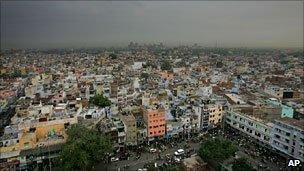Death-trap Delhi: Cowboy builders and venal officials
- Published

Mega-city Delhi is home to nearly 18 million people
What is an urban dweller to do when the city authorities won't provide adequate living space for a rapidly growing population?
In the Indian capital, Delhi, people simply build without permission on public and private land and bribe officials to turn a blind eye.
Then they sit tight and wait for politicians to legalise the housing colonies in exchange for votes come election time.
Delhi's population has grown from a little over two million in 1954 to nearly 18 million today.
The authorities only managed to build a little more than one million homes during this period.
The lack of adequately developed land at affordable rates has led to the messy growth of various unplanned settlements - from slum clusters and colonies to rural and urban villages, all within what is known as Delhi city.
So a third of the capital's residents have ended up living in several colonies - more than half of which are illegal; many of them have no legal electricity or water supply.
Vote bait
Many officials are not enthusiastic about taking action because illegal colonies can be rubber stamped in exchange for votes and money.
Chetan Dutt, a lawyer who launched a petition in 2006 that spurred Delhi High Court to order the demolition of over 18,000 illegal constructions in the city, says the illegal colonies first began cropping up in the 1960s.
A large number of Delhi's people live in slums
In 1972, the then Congress government legalised 800 such colonies.
Five years later, it did the same for another 567 colonies.
Between 1989 and 2002, illegal colonies were regularised by the government of the day at least five times.
"It is the pressure of the mob and politicians which has led to the regularisation of colonies," says Mr Dutt.
"This emboldens investors and builders to keep on encroaching and building because they are sure they will be legalised some day."
Delhi-based writer Jug Suraiya once wrote that "100% of Delhi is unauthorised".
Politicians and builders take money from the poor and the middle-class and encroach on public land to build grotty unplastered red-brick homes that dot much of the city.
The rich buy farmland to build plush farmhouses that they also rent out for parties and marriages or set up entirely illegal colonies like the 161-acre Sainik Farms where some of the city's most influential people - including army men and senior journalists - live.
Others sell their apartments or convert them into offices by bribing the police and municipal officials.
Business booms, and traffic clogs up residential roads even more.
'Mammoth problem'
Home and shop owners encroach upon the city's pavements, parking their cars or hawking their wares alongside openly menacing private warnings like - "Keep off the road" or "Tyres will be deflated if you park your car here".
There are thousands of illegal buildings in Delhi
Today, Delhi's pavements have either been encroached on or have shrunk as the authorities widen roads in a bizarre policy that is heavily loaded in favour of car owners. Pedestrians simply don't count.
The Municipal Corporation of Delhi, one of the world's largest city authorities, with a reputation for corruption and sloth, applied to the courts to fix the problem of unauthorised constructions.
Its officials said the reasons behind illegal buildings in Delhi were "the increasing needs of families, extension of existing houses, disappearance of the joint family system (extended families living under one roof), requirement of extra space for children etc".
The new master plan for the city - called Vision-2021 - aims to make Delhi a "global metropolis and a world-class city, where all the people are engaged in productive work with a decent standard of living and quality of life in a sustainable environment".
But critics say none of this will be possible unless there is a huge crackdown on corruption and a reform of the tainted institutions - the municipality and the Delhi Development Authority, which hold the key to the city's future.
In a sense, Delhi mirrors much of urban India's failure to meet the demands of a rapidly urbanising country as jobs dry up in the countryside.
The country has a shortage of over 20 million homes, 70% in the middle- and the low-income category.
It is a monumental failure which analysts say could easily snowball into a civil war of sorts over housing, water and electricity in the future.